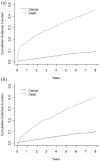The crosstalk between Stroke and Cancer: Incidence of cancer after a first-ever cerebrovascular event in a population-based study
- PMID: 37317526
- PMCID: PMC10472965
- DOI: 10.1177/23969873231181628
The crosstalk between Stroke and Cancer: Incidence of cancer after a first-ever cerebrovascular event in a population-based study
Abstract
Objectives: To determine the cancer incidence after the first-ever cerebrovascular event (CVE) and compare it to the cancer incidence in the population from the same region.
Methods: We evaluated 1069 patients with a first-ever CVE (Ischaemic or haemorrhagic stroke and Transient Ischaemic Attack) from a prospective population registry of stroke and transient focal neurological attacks, diagnosed between 2009 and 2011. We conducted a structured search to identify cancer-related variables and case-fatality for a period of 8 years following CVE. Cancer incidence in CVE patients was compared to the North Region Cancer Registry (RORENO).
Results: We found that 90/1069 (8.4%) CVE patients developed cancer after a first-ever CVE. Overall cancer annual incidence rate was higher after a CVE (820/100,000, 95%CI: 619-1020) than in general population (513/100,000, 95%CI: 508-518). In the 45-54 age group cancer incidence post-CVE was 3.2-fold (RR, 95%CI: 1.6-6.4) higher compared to the general population, decreasing gradually in older age-groups. Median time between CVE and cancer was 3.2 years (IQR = 1.4-5.2). Lower respiratory tract and colorectal were the most frequent cancer types. In univariable models, male sex (sHR = 1.78, 95%CI: 1.17-2.72, p = 0.007), tobacco use (sHR = 2.04, 95%CI: 1.31-3.18, p = 0.002) and peripheral artery disease (sHR = 2.37, 95%CI: 1.10-5.13, p = 0.028) were associated to higher cancer risk after CVE. After adjustment, tobacco use (sHR = 1.84, 95%CI: 1.08-3.14, p = 0.026) remained associated to a higher risk of cancer.
Conclusions: At the population level, patients presenting a first-ever CVE have higher cancer incidence, that is particularly prominent in younger age-groups. Higher cancer incidence, delayed cancer diagnosis and increased mortality post-CVE warrants further research on long-term cancer surveillance in first-ever CVE survivors.
Keywords: Stroke; Transient Ischaemic Attack; cancer; incidence; population study.
Conflict of interest statement
The author(s) declared no potential conflicts of interest with respect to the research, authorship, and/or publication of this article.
Figures



Similar articles
-
Stroke frequency, associated factors, and clinical features in primary systemic vasculitis: a multicentric observational study.J Neurol. 2024 Jun;271(6):3309-3320. doi: 10.1007/s00415-024-12251-1. Epub 2024 Mar 12. J Neurol. 2024. PMID: 38472397 Free PMC article.
-
Denial of Cerebrovascular Events in a National Clinical Quality Registry for Stroke: A Retrospective Cohort Study.J Stroke Cerebrovasc Dis. 2022 Feb;31(2):106210. doi: 10.1016/j.jstrokecerebrovasdis.2021.106210. Epub 2021 Dec 2. J Stroke Cerebrovasc Dis. 2022. PMID: 34864608
-
Diagnosis of non-consensus transient ischaemic attacks with focal, negative, and non-progressive symptoms: population-based validation by investigation and prognosis.Lancet. 2021 Mar 6;397(10277):902-912. doi: 10.1016/S0140-6736(20)31961-9. Lancet. 2021. PMID: 33676629 Free PMC article.
-
Cardiovascular and Cerebrovascular Events After Parathyroidectomy in Patients on Renal Replacement Therapy.World J Surg. 2019 Aug;43(8):1981-1988. doi: 10.1007/s00268-019-05020-z. World J Surg. 2019. PMID: 31087130
-
[SENTIERI - Epidemiological Study of Residents in National Priority Contaminated Sites. Sixth Report].Epidemiol Prev. 2023 Jan-Apr;47(1-2 Suppl 1):1-286. doi: 10.19191/EP23.1-2-S1.003. Epidemiol Prev. 2023. PMID: 36825373 Italian.
Cited by
-
Epigenetic age and long-term cancer risk following a stroke.Genome Med. 2024 Nov 22;16(1):135. doi: 10.1186/s13073-024-01408-2. Genome Med. 2024. PMID: 39578904 Free PMC article.
-
The influence of baseline platelet on mortality risk in stroke and cancer patients: a cross-sectional analysis of the NHANES database.BMC Neurol. 2025 Jan 22;25(1):30. doi: 10.1186/s12883-025-04043-5. BMC Neurol. 2025. PMID: 39844121 Free PMC article.
References
-
- World Health Organization. Global Health Estimates: life expectancy and leading causes of death and disability, https://www.who.int/data/gho/data/themes/mortality-and-global-health-est... (2020, accessed 6 February 2021).
-
- Graus F, Rogers LR, Posner JB. Cerebrovascular complications in patients with cancer. Medicine 1985; 64: 16–35. - PubMed
Publication types
MeSH terms
LinkOut - more resources
Full Text Sources
Medical

